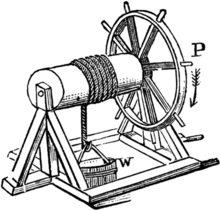Wheel
Awheelis adiscorcircle-shaped mechanical device. Its main purpose is to allow things toroll;in other words, the wheel spins, and object on the wheels moves more easily along the ground. It is asimple machine.[1]The principle behind the wheel is that ofmechanical advantage.[2]


Most landvehiclesroll on wheels. Wheels are often used in pairs, connected by a rod of wood or metal known as anaxle.The wheel and axle turn together. The part of the wheel that attaches to the axle is called the hub.
The wheel with an axle is the basis of many machines, not just vehicles. Thepotter's wheel,thelatheand thewindlassare examples.[2]Many machines have wheels with teeth, known asgears.
History
changeMost experts believe that the ancientMesopotamiansinvented the wheel about 4000 BC.[3][4]
People inAsiaalso discovered it on their own around 3500 BC. TheIncaandMayahad wheels on children's toys around 1500 BC, but they did not use wheels for work.Africasouth of theSaharadesert andAustraliadid not have the wheel until people there met people from Europe. Early wheels were soliddisks;thespokedwheel was invented around 2000 BC. The earliest documentation of a vehicle with wheels is a painting dated between 3350–3500BC.
Uses
changeToday, wheels are used incars,carts,airplanes,wheelchairs,bicycles,trains,andskateboards,in addition to many more devices.
References
change- ↑Prater, Edward L. 1994.Basic Machines,Naval Education and Training Professional Development and Technology Center, NAVEDTRA 14037
- ↑2.02.1Bowser, Edward Albert, 1890,An elementary treatise on analytic mechanics: with numerous examples.(Originally from the University of Michigan) D. Van Nostrand Company, pp. 190
- ↑True potter's wheels, which are freely-spinning and have a wheel-and-axle mechanism, were developed inMesopotamia(Iraq) by 4200–4000 BC.D.T. Potts (2012).A Companion to the Archaeology of the Ancient Near East.p. 285.
- ↑The oldest surviving example, which was found inUr(modern dayIraq), dates to about 3100 BC.